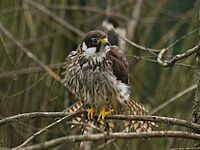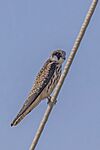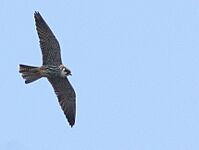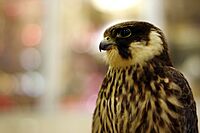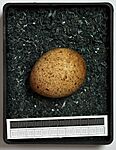Eurasian hobby facts for kids
Quick facts for kids Eurasian hobby |
|
|---|---|
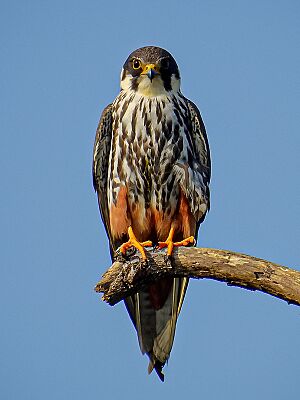 |
|
| Falco subbuteo passage migrant in Mangaon, Raigad, Maharashtra, India | |
| Conservation status | |
| Scientific classification | |
| Genus: |
Falco
|
| Species: |
subbuteo
|
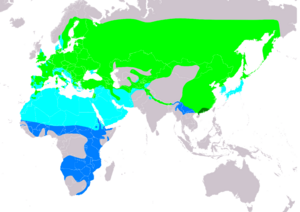 |
|
| Range of F. subbuteo Breeding Resident Passage Non-breeding | |
The Eurasian hobby (also called just hobby) is a small, slim falcon. It's known for its amazing flying skills! This bird is part of a group of similar falcons.
Contents
What's in a Name?
The Eurasian hobby got its official scientific name, Falco subbuteo, in 1758 from a Swedish scientist named Carl Linnaeus. The word Falco comes from a Latin word meaning "sickle," which describes the shape of the hobby's wings when it flies. Subbuteo means "less than a buzzard" in Latin. The English name "hobby" comes from an old French word. Fun fact: A famous table game company called Subbuteo was named after this bird because its creator loved birds!
Different Types of Hobbies
There are two main types, or subspecies, of the Eurasian hobby:
- F. s. subbuteo: This type lives in places like Africa, Europe, and parts of Asia. It flies south to Africa and South Asia for the winter.
- F. s. streichi: This type is a bit smaller. It lives in Myanmar, southern China, and northern Indochina all year round.
What Does a Hobby Look Like?
Adult hobbies have a dark, slate-grey back and a dark head. They have two short black stripes that look like a mustache on their face. Their throat is white, and their upper legs and the feathers under their tail are a reddish-brown color. The rest of their belly is whitish with black streaks. If you get a close look, you might see their red "trousers" and vent (the area around their tail). Both male and female hobbies look very similar.
Young Hobbies
Young hobbies are usually browner than adults. Their upper feathers have a scaled look, and their legs and undertail feathers are streaky and buffy (a pale yellowish-brown).
Size of the Hobby
This falcon is about 29 to 36 centimeters (11 to 14 inches) long. Its wings can spread out from 74 to 84 centimeters (29 to 33 inches) wide. A hobby weighs between 175 and 285 grams (6 to 10 ounces), which is about the weight of a can of soda.
Where Do Hobbies Live?
Eurasian hobbies breed across a large area called the Palearctic realm, which includes Europe and Asia. The F. s. subbuteo type travels long distances, flying to Africa for the winter. The F. s. streichi type usually stays in the same area all year and does not migrate.
Hobby Habitats
These birds like open areas such as farmland, marshes, and savannah. They are often found in lowlands where there are scattered small woods.
Hobby Behaviour and Life
The hobby is a very graceful bird of prey. When it flies, its long, pointed wings and square tail make it look like a sickle. It can even look like a swift when it glides with its wings folded. Hobbies are fast and powerful flyers.
What Do Hobbies Eat?
They catch large insects, like dragonflies, right out of the air! They are very clever: they transfer the insect from their talons (claws) to their beak and eat it while flying in circles. They also catch small bats and small birds while flying. Their speed and amazing flying skills allow them to catch birds like swallows and even swifts in mid-air. Barn swallows and house martins have a special alarm call they use when a hobby is near. Hobbies are known to bother swallows when they are resting or leaving their resting spots.
When Do Hobbies Hunt?
When they are not breeding, hobbies mostly hunt in the mornings and evenings. When they are migrating, they might fly in small groups.
Reproduction and Nests
Hobbies don't build their own nests. Instead, they use old nests made by crows or other birds. They often choose a tree that is in a hedge or at the very edge of a small group of trees. This allows them to watch for anyone approaching from far away. A female hobby usually lays 2 to 4 eggs. Both parents help to incubate the eggs, which takes about 28 days, but the female does most of the work.
Hobbies and Falconry
The Eurasian hobby is a very brave and bold bird. In the past, people used them in falconry. This means they were trained to hunt other birds like quails, larks, and hoopoes.
Gallery



